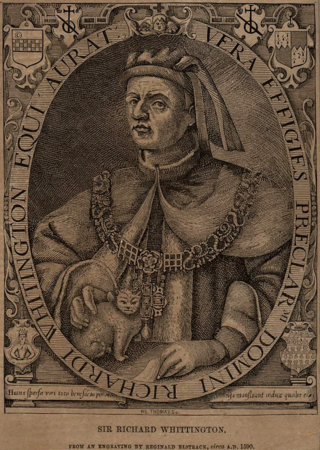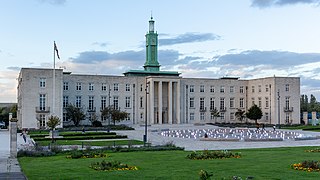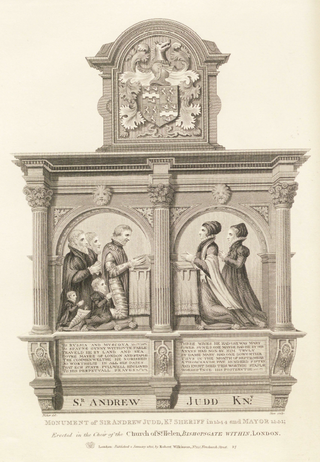Related Research Articles

Richard Whittington of the parish of St Michael Paternoster Royal, City of London, was an English merchant and a politician of the late medieval period. He is also the real-life inspiration for the English folk tale Dick Whittington and His Cat. He was four times Lord Mayor of London, a member of parliament and a Sheriff of London. In his lifetime he financed a number of public projects, such as drainage systems in poor areas of medieval London, and a hospital ward for unmarried mothers. He bequeathed his fortune to form the Charity of Sir Richard Whittington which, nearly 600 years later, continues to assist people in need.

Walthamstow is a town in the London Borough of Waltham Forest, around 7.5 miles (12 km) east of Central London. The town borders Chingford to the north, Snaresbrook and South Woodford to the east, Leyton and Leytonstone to the south, and Tottenham to the west. At the 2011 census, the town had a population of approximately 109,424.
Charles Bathurst PC, known as Charles Bragge from 1754 to 1804, was a British politician of the early 19th century.

Sir Anthony Denny was Groom of the Stool to King Henry VIII of England, thus his closest courtier and confidant. In 1539 he was appointed a gentleman of the privy chamber and was its most prominent member in King Henry's last years, having together with his brother-in-law, John Gates, charge of the "dry stamp" of the King's signature, and attended the King on his deathbed. He was a member of the Reformist circle that offset the conservative religious influence of Bishop Gardiner. He was a wealthy man, having acquired several manors and former religious sites distributed by the Court of augmentations after the Dissolution of the Monasteries. By 1548, he was keeper of the Palace of Westminster.
Sir George Monoux College is a sixth form college located in Walthamstow, London. It is a medium-sized college with around 1,620 full-time students as of 2018.

Sir William Holles rose from apprenticeship to a mercer to become master warden of his company and Lord Mayor of London in 1539.
Events from the 1520s in England.

Purleigh is a village on the Dengie peninsula about 4 miles (6.4 km) south of Maldon in the English county of Essex. The village is part of the Purleigh ward of the Maldon district.
Stephen Vaughan (1502-1549) was an English merchant, royal agent and diplomat, and supporter of the Protestant Reformation.

Edward North, 1st Baron North was an English peer and politician. He was the Clerk of the Parliaments 1531–1540 and Lord Lieutenant of Cambridgeshire 1557–1564. A successful lawyer, he was created the first Baron North, giving him a seat in the House of Lords.
Sir John Pakington, was Chirographer of the Court of Common Pleas, a Member of Parliament for Gloucester, and Sheriff of Herefordshire and Worcestershire. In 1529 he received an extraordinary grant from Henry VIII permitting him to wear his hat in the King's presence.

Sir William Denys of Dyrham, Gloucestershire, was a courtier of King Henry VIII and High Sheriff of Gloucestershire in 1518 and 1526. The surname is sometimes transcribed as Dennis.

Edmund Withypoll, Esquire, of London, of Walthamstow, Essex, and of Ipswich, Suffolk, was an English merchant, money-lender, landowner, sheriff and politician, who established his family in his mother's native county of Suffolk, and built Christchurch Mansion, a distinguished surviving Tudor house, as his Ipswich home.
John Browne II, of London and Horton Kirby, Kent, was Warden of the Mint and MP for Aldborough.
Sir William Chester was one of the leading English Merchants of the Staple and Merchant Adventurers of the mid-16th century, five times Master of the Worshipful Company of Drapers, Lord Mayor of London in the year 1560–61 and Member of Parliament for the City of London. He should not be confused with his contemporary, William Chester, merchant of Bristol, M.P.
Sir Thomas Cooke was an English merchant and Lord Mayor of London.

Sir Andrew Judde or Judd was a 16th-century English merchant and Lord Mayor of London. He was knighted on 15 February 1551.
Sir Samuel Vanacker Sambrooke, 3rd Baronet of Bush Hill, Enfield, Middlesex, was a British landowner and politician who sat in the House of Commons as MP for Bramber and Great Bedwyn.
References
- ↑ B. Morgan, 'Monoux, George (b. in or before 1465, d. 1544), merchant and local politician', Oxford Dictionary of National Biography.
- ↑ A.B. Beavan, The Aldermen of the City of London Temp. Henry III to 1912 (Corporation of the City of London, 1913), II, p. 22. Some relationships described in this work are unreliable.
- ↑ H. Miller, 'Monoux, George (by 1465-1544), of Bristol, Glos.; London and Walthamstow, Essex', in S.T. Bindoff (ed.), The History of Parliament: the House of Commons 1509-1558 (Boydell & Brewer 1982). History of Parliament online.
- ↑ British Library Add. MS 18783, fol. 5.
- ↑ Will of George Monoux of Walthamstow, Essex (P.C.C. 1544).
- ↑ W.R.Powell, ed. (1973). "Walthamstow: Churches". A History of the County of Essex: Volume 6. Institute of Historical Research.
- ↑ "Walthamstow Pages 204-230 The Environs of London: Volume 4, Counties of Herts, Essex and Kent". British History Online. T Cadell and W Davies, London, 1796. Retrieved 23 January 2024.
- ↑ "Our History". Sir George Monoux College. Archived from the original on 10 December 2012.